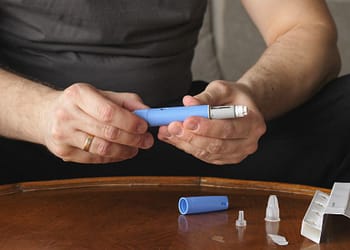Fluidasa is a medication designed to relieve respiratory distressIt is used in cases of acute and chronic bronchitis, both in adults and children.
The active ingredient is mepifylline, a combination of two substances: a xanthine and an antihistamine. Together, they work by opening the bronchial tubes and improving breathing. Thanks to this formula, Fluidasa reduces inflammation in the airways. It also helps air flow better to the lungs. Each milliliter of the syrup contains 5 mg of mepifylline. It also contains sorbitol, sweeteners, and preservatives, such as parahydroxybenzoates.
Who is it suitable for?
It is indicated for people with bronchitis, whether occasional or chronic. It can be used in both children and adults, always following the appropriate dosage. Fluidasa is not a mucolytic. Its purpose is to combat bronchoconstriction, when the bronchi narrow and make it difficult to breathe.
What dose is recommended?
The amount depends on the weight, age, and severity of the case. Generally, the daily dose is divided into four doses. Children under 5 years: 1 to 2 5 ml doses, three or four times a day.
- Children over 5 years: 2 to 3 5 ml doses, three or four times a day.
- Adults: 1 to 2 15 ml doses, four times a day.
In more severe cases, injectable treatment is available. The syrup is administered orally using the included measuring cup.
Who should not take it?
There are situations in which Fluidasa is not recommended. For example, for people allergic to any of its components or with serious liver problems. Those with glaucoma, urinary retention, or prostatic hypertrophy should also not take it. It is not indicated for newborns or premature babies.
During treatment, it's best to avoid alcohol. This is because it can increase the sedative effects of the medication. In older people, side effects may be more pronounced. Therefore, it's key to monitor for dizziness, confusion, or dry mouth.
Fluidasa contains sorbitol. This may cause discomfort in people with fructose intolerance or digestive problems. It also contains parahydroxybenzoates, which can cause mild allergic reactions, even with prolonged use.
This medicine May enhance the effects of some medications, especially those that depress the central nervous system. If you are taking tricyclic antidepressants, sedatives, or monoamine oxidase inhibitors, you should consult your doctor first. doctor.
It can also affect skin tests with allergens. Therefore, it is recommended to discontinue the medication at least 72 hours before the test.
And during pregnancy or breastfeeding?
There is insufficient data on its safety during pregnancy. Although animal studies show no risks, it is not recommended during this period. It is also not recommended during breastfeeding, as it has not been determined whether it passes into breast milk.
Possible side effects
The most common side effect is drowsiness. Dizziness, blurred vision, dry mouth, or stomach upset may also occur. In less common cases, rapid heartbeat, confusion, or skin rashes have been reported. These are rare reactions, but it's important to be alert.
If any of these symptoms appear and persist, it is advisable to discontinue treatment and consult a healthcare professional.
Excessive doses can cause symptoms such as clumsiness, dryness, severe dizziness, or even hallucinations. In children, it can cause agitation or seizures.
In these cases, the key is to act quickly. Blood pressure must be controlled, the airways kept clear, and symptomatic treatment administered. If seizures occur, intravenous diazepam can be administered. Oxygen may also be required, and in some cases, assisted respiration.
Fluidasa may cause drowsiness. This affects your ability to drive or operate machinery safely. It's important to monitor your body's reaction. If you experience drowsiness, avoid activities that require concentration or quick reflexes.
How is it absorbed into the body?
Fluidase is absorbed through the digestive tract. It reaches its peak blood levels between two and four hours after ingestion. It is then metabolized in the liver and eliminated in urine and feces. Its half-life is approximately three and a half hours.
How to preserve it and what presentation does it come in?
The bottle contains 250 ml of syrup and comes with a measuring cup. It should be stored below 25°C and kept out of the reach of children. It should not be mixed with other medications. It also expires three years after the date of manufacture.






